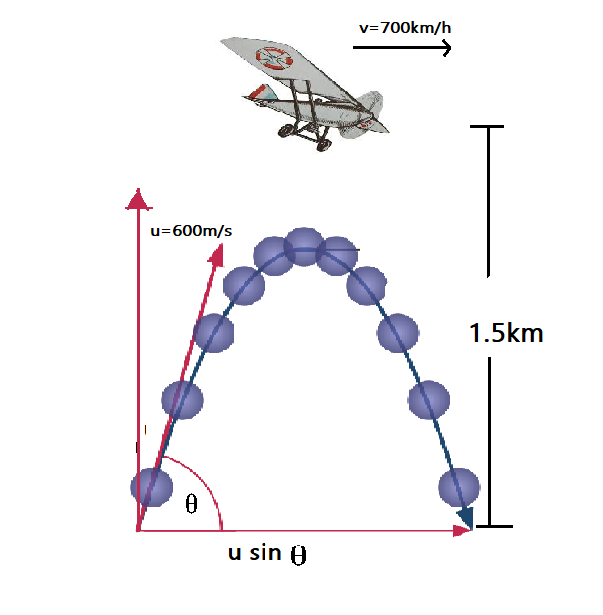Question
Question: A fighter plane flying horizontally at an altitude of \[1.5km\] with speed \(720km/h\) passes direct...
A fighter plane flying horizontally at an altitude of 1.5km with speed 720km/h passes directly overhead an anti-aircraft gun. At what angle from the vertical should the gun be fired for the shell with muzzle speed 600ms−1 to hit the plane? At what minimum altitude should the pilot fly the plane to avoid being hit? (Take g=10ms−2)
Solution
Hint: This can be solved by the projectile motion where usinθ=vt. Since the plane is already at certain height above the ground, we must check, the max height, till where the shell can reach Hmax=2gu2sin2(90−θ).
Formula used: usinθ=vt
Hmax=2gu2sin2(90−θ)
Complete step-by-step solution -
This is a projectile motion sum where,
Height of the fighter plane=1.5km=1500m
Speed of the plane v=720km/h=200m/s
Let θ be the angle, when the shell hits the plane.
Muzzle velocity u=600m/s
Time taken to hit the plane=t
Horizontal distance travelled, from second equation of kinematic motion.=uxt
Distance travelled by the plane=vt

The shell will hit the plane if the above distances are equal.
uxt=vt
usinθ=vt
sinθ=vu=600200=0.33
θ=sin−1(0.33)≈19∘
To avoid being hit, the plane must fly at Hmax=2gu2sin2(90−θ)=2×10u2cos2θ=206002cos219=20(600×0.945)2=16092=16km
Since it is already flying at 1.5km height it must fly above by another 16km to avoid being hit by the shell.
Note: Projectile motion occurs when an object is projected at a certain angle from the surface, it moves along a curved path called trajectory under the action of gravity. This curved path is of the shape of a parabola.
The various formulas used are
Time of flight=g2v0sinθ
Maximum height Hmax=2gu2sin2(90−θ)
Horizontal range R=gu2sin2(90−θ)
Where, v0 is the initial velocity, with sinθ;cosθ as the y-axis and x-axis component respectively.
